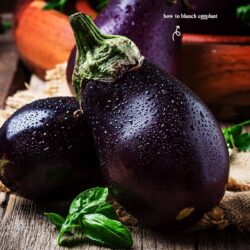Blanching Eggplant for Freezing
Pin RecipeHere’s the proper way on how to blanch eggplant to prevent bacteria from destroying the nutrients and change the color, flavor, and texture of food during frozen storage.
Servings: 2 bags
Equipments:
- Vacuum food sealer
- vacuum sealer bags or Ziplock bags
- Cutting board
- Knife
- Big bowl for an ice bath
Ingredients:
- 2 fresh eggplants
- ½ cup lemon or lime juice
- water (for blanching)
Watch the Video:
Instructions:
- Ensure the eggplant is harvested or bought while the skin is a nice dark color overall, and before the seeds inside have matured. Wash the eggplant thoroughly.
- Using a sharp knife, chop off the ends about one-quarter of an inch. Now remove the eggplant’s skin. I find that an ordinary vegetable peeler works best.
- Cut into round slices – about one-third of an inch thick. Don’t dawdle. If peeled eggplant is left exposed to the air for more than half an hour, it will begin to discolor.
- Fill a pan two thirds with water, and add half a cup of fresh lemon juice. (Half a cup for each gallon of water). Fill a large bowl with cold water and lots of ice. You will need this to rapidly cool the fruit once you remove it from the pan of hot water.
- Carefully immerse the eggplant slices into the boiling water. As it has been sliced relatively thinly, it only needs blanching for about 3 ½ minutes. Start the countdown immediately after pouring the slices into the boiling water. Cover, and continue to boil for the recommended time.
- When the time is up, take the slices out of the boiling water using a slotted spoon and place straight into the bowl of iced water you’ve prepared. Allow the slices to sit there for five minutes or so until they become cold. This rapid cooling immediately stops any further cooking. Add more fresh ice if necessary.
- If you own a FoodSaver® vacuum sealer, you will know they are great for sealing foodstuffs before freezing. If you haven’t yet invested in one, a Ziploc bag works nearly as well, although it’s more difficult to get all the air out of it before you seal it. Removing the air helps prevent freezer burn, and it is a fantastic way of sealing food items.
- Put the bagged, sliced eggplant into your freezer. If you have a quick freeze shelf, use it.
Notes:
1.) If you don’t own a vacuum food sealer and use Ziploc bags, after putting the food inside the bag, zip it up but leave it slightly open at one end; just enough, you can insert a soda straw into the bag. With the straw in position, suck the air out. To remove the straw, squeeze it where it enters the bag, and pull it out while zipping the bag up. The job is done.
2.) Pick or buy eggplant when it is at peak readiness – when it feels firm, not limp. Cook it as soon as possible, or if there will be a delay before you do, keep it cool with ice, or store in your fridge for no more than two days max.
Please note that all nutrition information are just estimates. Values will vary among brands, so we encourage you to calculate these on your own for most accurate results.
Did you make this?I would love seeing what you've made! Tag me on Instagram @theforkbitedotcom or leave me a comment or rating below.
